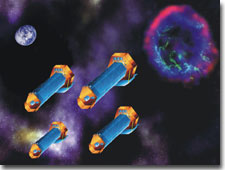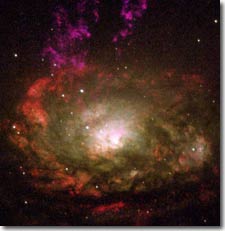Black Holes
A star exists in a delicate balance between the crushing force of gravity, on the one hand, and the push of incredibly hot gases on the other. This balance exists as long as there is fuel for the fusion process that powers the star.
What happens when the star runs out of fuel? Then, gravity collapses the star. The more massive the star, the more drastic the collapse and the more condensed the remaining object.
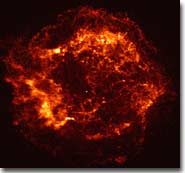
Cas A is the remnant of a star that exploded about 300 years ago. The X-ray image shows an expanding shell of hot gas produced by the explosion. Courtesy of NASA/CXC/SAO
A star about the size of the sun:
The collapse produces enough pressure to squeeze atoms right out of existence, leaving electrons and nuclei packed tightly together in an object about the size of Earth. The result is called a white dwarf.
A star six to eight times larger than the sun:
Upon exhausting its nuclear fuel, a star this large undergoes a catastrophic explosion as a supernova. (See Neutrino Astrophysics) The force of gravity in the leftover object is so strong that the electrons are jammed into the nuclei to make a neutron star, with a diameter of only about 16 km.
A star ten or more times larger than the sun:
At this size, the force of gravity collapses the neutron core right out of existence to form a black hole. Gravity near the black hole is so strong that nothing can escape, not even light. More precisely, any matter or radiation inside a sphere called the event horizon falls inward and cannot escape. (See drawing.) For a black hole with ten times the mass of the sun, the radius of the event horizon is about 30 km.
History of Black Holes
The existence of black holes was predicted well before the 20th century. About a hundred years after Newton worked out his theory of gravitation, the English astronomer John Michell recognized in 1784 the possibility that the gravity of a very large star might be so great that nothing, not even light, could escape it.
In fact, a correct description of a black hole requires Einstein's general theory of relativity. Armed with this theory, Karl Schwartzschild in 1916 found a solution of Einstein's equations corresponding to the simplest kind of black hole. In the 1930s, other physicists, including Robert Oppenheimer, who later became the director of the Manhattan Project, produced more detailed calculations. John Wheeler coined the name “black hole.”
After a Star's Gravitational Collapse


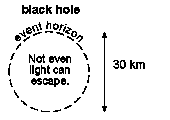
Seeing Black Holes
Text courtesy of NASA
Astrophysicists measure how forces of extreme gravity operate near a black hole by mapping the distortions of space-time predicated by Einstein's Theory of General Relativity. There are two classes of black holes: galactic black holes, the remains of massive stars 10-100 times the size of our Sun, and supermassive black holes, the powerhouses in the centers of galaxies that range up to billions of solar masses in size. Our own Galaxy harbors thousands of stellar black holes, and new observations show that most galaxies, including possibly our own, have a supermassive black hole at their core. Within both classes of black holes, space and time as we know it collapse. Thus, black holes are cosmic laboratories, allowing us to explore the ultimate limits of our physical laws and of gravity.
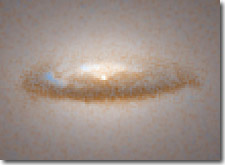
Disk around a black hole in Galaxy NGC 7052. Hubble image courtesy of NASA
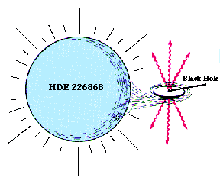
A black hole and a companion star orbiting each other; the black hole pulls matter in from the star; this matter moves in a spiral and gives off a characteristic x-ray spectrum; drawing courtesy of NASA
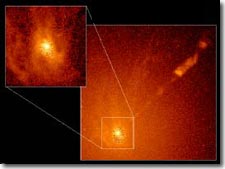
Rotating gas disk in M87; measurements of its rotation rate provide a mass for the central object, which is about three billion solar masses; image courtesy of NASA
One unavoidable challenge when studying black holes, however, is that they're almost invisible. A black hole is defined by a surface called the event horizon, the point at which gravity is so strong that nothing, not even light, can escape. The stellar matter itself is crushed into a singularity at the center, hidden behind the event horizon. The event horizon of a galactic black hole is only a few miles across. In supermassive black holes, it is only about the size of our Solar System.
Supermassive black holes are likely the power source for Active Galactic Nuclei (AGN), the bulging glow seen in many galactic cores. AGNs might be the result of a huge black hole gobbling up whole stars and pulling dust and gas from the nearby interstellar medium with such fury that the energy produced in this relatively small region (the size of our Solar System) outshines the entire galaxy.
How do we go about observing black holes if they are so compact and emit no visible light? There are a couple of tricks. Stellar black holes are often part of a binary star system, two stars revolving around each other. What we see from Earth is a visible star orbiting around what appears to be nothing. In reality, it is orbiting around the black hole. We can infer the mass of the black hole by the way the visible star is orbiting around it. The larger the black hole, the greater the gravitational pull, and the greater the effect on the visible star.
Another way we can “see” a black hole is by observing X-rays generated around it. Because a black hole has such a powerful gravitational force, a galactic black hole in a binary system can literally tear apart its companion star. Gas from the companion swirls into the black hole like water down a drain. The swirling gas is what we call an accretion disk. As the gas gets closer to the black hole, it heats up from the friction of ever faster moving gas molecules. just outside the black hole's event horizon, the gas heats to temperatures in the range of millions of degrees. Gas heated to these temperatures releases tremendous amounts of energy in the form of X-rays.
Supermassive black holes also have an accretion disk that emits X-rays. This is formed not by a single star, as in a binary system, but by the great amounts of gas present in the regions between stars. In about 10 percent of supermassive black holes, jets of energized matter thousands of light-years in length shoot out in opposite directions. This can be detected in radio, visible, X-ray and gamma-ray wavelengths. These jets accelerate matter to nearly the speed of light through a mechanism not well understood.
From small to large-scale black holes, many questions abound: How is material fed directly into the black hole? How do jets form? Why do some black holes have jets, while many more do not? What keeps the jets powered for millions of years? Why are AGNs more common in the past than today? How do supermassive black holes participate in the formation and evolution of galaxies? What are the masses and spins of black holes?
Exploring the Universe
Text courtesy of NASA
Different types of telescopes detect different types, or wavelengths, of light--from microwaves to visible light (what our eyes can detect) to high energy X-ray photons and gamma rays. Each wavelength band is important for composing a full view of the Universe. Optical telescopes, such as Hubble Space Telescope, generate brilliant images of stars and galaxies, both near and far. Hubble also measures the sizes, distances and compositions of celestial objects. Radio telescopes, however, were the first to detect quasars, extremely distant galaxies that emit incredible amounts of radio energy. Radio telescopes also provided the first evidence of planets outside our Solar System. Infrared telescopes have identified dust clouds between stars and galaxies, as well as “nurseries” for possible star formation. High energy gamma-ray telescopes have discovered the most energetic explosion since the Big Bang. Thus, the entire electromagnetic spectrum is important for a complete picture, because different objects emit the bulk of their radiation at different wavelengths. Black holes are best detectable at high energies—that is, in X-rays and gamma rays.
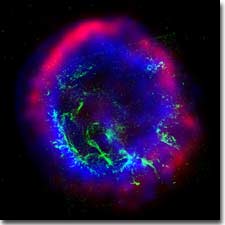
Color composite of the supernova remnant E0102-72: X-ray (blue), optical (green), and radio (red). Hubble, Chandra, Australia Telescope Compact Array.. Courtesy of NASA
An X-ray telescope collects photons created naturally in some of the most violent and energetic events in the Universe: such as supernova explosions and the rapid flow of gas under the extreme gravitational pull of a black hole. This mechanism for collecting photons is quite different from taking an “X-ray” of a broken bone. Unlike a medical X-ray machine, the X-ray telescope doesn't generate X-ray photons. Rather, it collects these tiny packets of high energy that form at extremely high temperatures. X-ray detectors on satellites are like the film in the doctor's X-ray machine.
The Sun produces some X-rays, particularly during a solar flare. However, X-ray telescopes focus far beyond our Solar System and can study black holes, stellar explosions, galaxies that release great amounts of X-rays from their centers, and the pervasive, but optically invisible, hot gas that dominates space between stars and galaxies.
Constellation X-ray Mission
Text courtesy of NASA
Like all X-ray telescopes, Constellation-X must be positioned in space because X-ray light does not penetrate the Earth's atmosphere. Yet, in designing Constellation-X, scientists wanted an X-ray telescope similar to the large Earth-bound telescopes to collect as much X-ray light as possible. These requirements led to the Constellation-X's unique multi-satellite design. The four satellites are light enough to be launched individually or in pairs, yet combine to provide a sensitivity 100-times greater than any past or current X- ray satellite mission. Essentially, scientists will be able to collect more data in an hour than they would have collected in days or weeks with current X-ray telescopes. We will learn about thousands of faint X- ray emitting sources, not just the bright sources available to us today.
The multi-satellite design also saves money and reduces risk. It is less expensive to build and launch smaller, identical telescopes. And with separate launches for individual telescopes - or perhaps for pairs of telescopes, if the design permits - we avoid putting all our eggs in one rocket, so to speak.
Constellation-X is modeled after the Keck Observatory, twin optical telescopes each 10 meters (33 feet) wide, positioned high atop Mauna Kea in Hawaii. Both observatories have superior collecting areas, or apertures, for analyzing the components of light. Both Keck and Constellation-X are the complements to the great high-angular-resolution space telescopes: the Hubble Space Telescope and the Chandra X-ray Observatory, respectively. No single telescope can do it all. Hubble, along with its many excellent features, provides fantastic images of distant galaxies with unprecedented clarity. The Earth-based Keck supports Hubble, however, by collecting enough light waves to study the gas in those distant galaxies. Likewise, the Chandra Observatory, to be launched by the year 2000, will have the best imaging resolution of any X-ray telescope so far. Scientists will then use the unparalleled data from Constellation-X together with Chandra in analyzing X-ray light and forming a more complete picture of the X-ray Universe.
Constellation-X will document these objects and regions with images, and, more importantly, with spectra. Spectra, the soul of Constellation-X, are like the fingerprints of elements in far-away stars and dusty clouds of hot gas. These diagrams of spectral energy patterns can reveal almost every characteristic of a distant gas, solely from the light it emits. With high- resolution X-ray spectroscopy, we can zoom in to within a few kilometers of the border of a black hole, as close to the black hole itself as any observations can theoretically get. Spectra can be used to see how extreme gravity around a black hole affects the composition, pressure, density, temperature and velocity of the gas swirling into it. Spectra of black holes, supernova remnants and galaxy clusters provided by Constellation-X will be the next best thing to reaching out and touching these objects with our hands.
Space. Time. Energy.
The Constellation X-ray Observatory (or Constellation-X) is a next-generation X-ray telescope satellite that will investigate black holes, Einstein's Theory of General Relativity, galaxy formation, the evolution of the Universe on the largest scales, the recycling of matter and energy, and the nature of “dark matter” Planned as four individual X-ray space telescopes operating together, Constellation-X will help us understand the great mysteries of space, time and energy.
Constellation-X's large X-ray collecting area and superior resolution, or clarity, will provide the most detailed, quantitative observations of the region surrounding a black hole. Data from current telescopes can take us near a black hole, but Constellation-X will take us to within a few miles of its edge. It will be able to measure the mass and spin of a black hole, two of its defining characteristics.
Such measurements will enable scientists to begin to answer the many questions that remain about the formation and evolution of black holes, and about how the laws of physics behave in extreme environments.
Links
NASAUniversity of California at Berkeley
Cambridge University
University of Illinois
Harvard-Smithsonian Center for Astrophysics
Space Telescope Science Institute
- The Truth about Black Holes (lesson plan)










